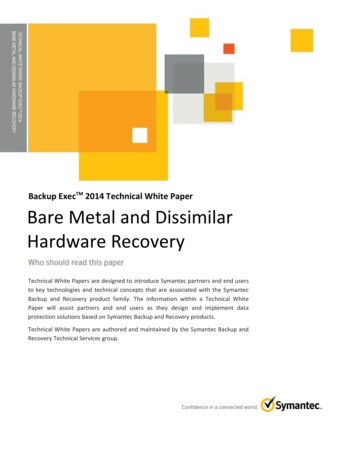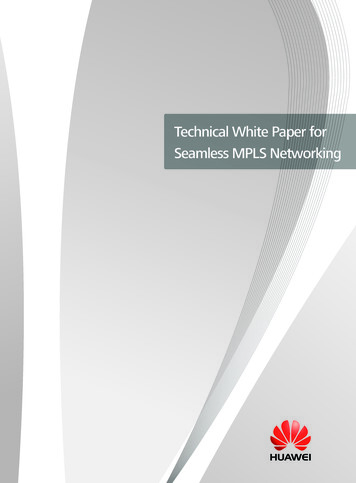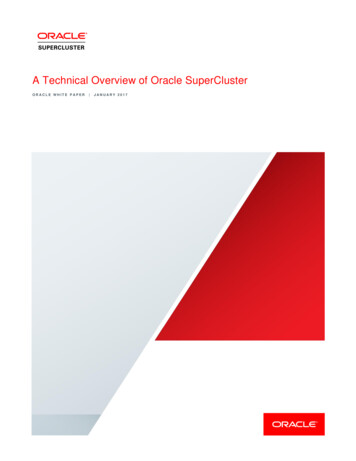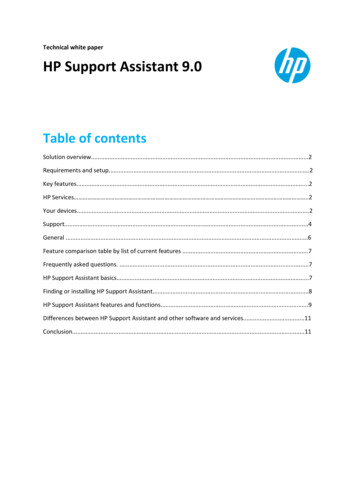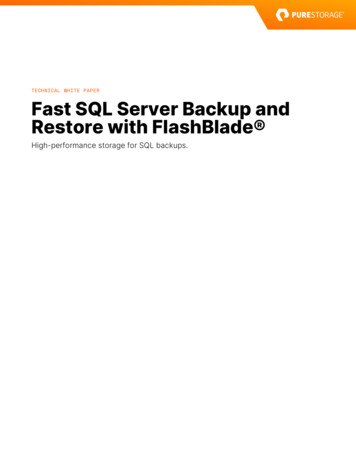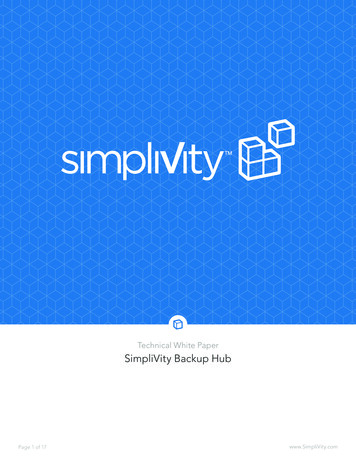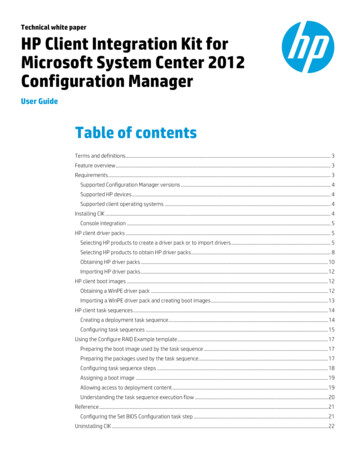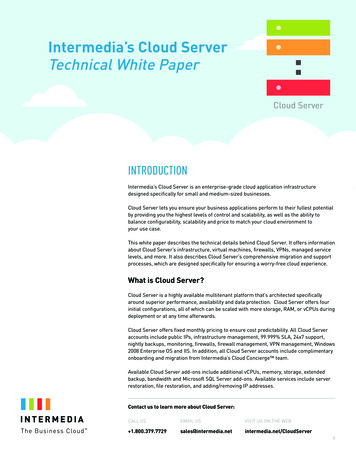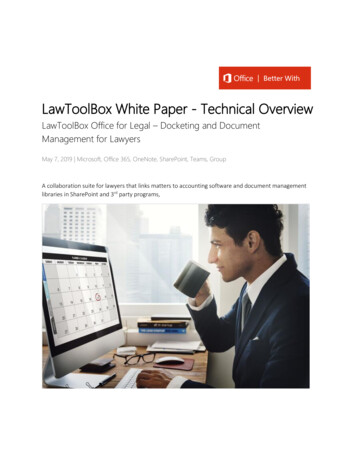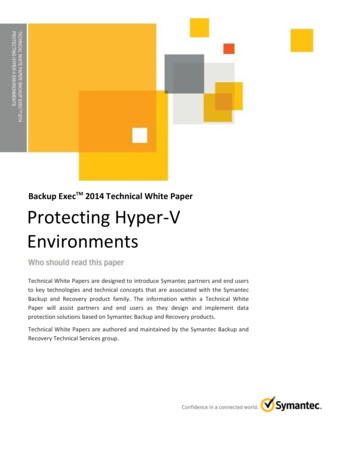
Transcription
TECHNICAL WHITE PAPER: BACKUP EXECTM 2014PROTECTING HYPER-V ENVIRONMENTSBackup ExecTM 2014 Technical White PaperProtecting Hyper-VEnvironmentsTechnical White Papers are designed to introduce Symantec partners and end usersto key technologies and technical concepts that are associated with the SymantecBackup and Recovery product family. The information within a Technical WhitePaper will assist partners and end users as they design and implement dataprotection solutions based on Symantec Backup and Recovery products.Technical White Papers are authored and maintained by the Symantec Backup andRecovery Technical Services group.
2
ContentsIntroduction . 4Business Value . 5Underlying Backup Principles . 9Virtualized Application Protection. 13Virtual Machine Recovery Options . 15Improved Usability for Virtual Environments . 17Example Hyper-V Configurations. 18Performance Recommendations . 19Notes and Best Practices . 21For More Information . 233
IntroductionThis white paper is intended to assist partners and end users as they design and implement Backup Exec 2014in Hyper-V environments and make related decisions. The business value of Backup Exec 2014 in Hyper-Venvironments is also covered.This white paper includes the following topics: Business Value Underlying Backup Principles Virtualized Application Protection Virtual Machine Recovery Options Improved Usability for Virtual Environments Example Hyper-V Configurations Performance Recommendations Notes and Best PracticesFor step-by-step instructions for installing and managing Backup Exec 2014 and the Agent for VMware andHyper-V, refer to the Symantec Backup Exec 2014 Administrator’s Guide available here: TECH205797.4
Business ValueVirtualization technology has been widely adopted by organizations of all sizes to optimize critical IT assets,such as data and application servers. As a result of this virtualization trend, companies are looking for efficientand effective ways to back up and recover their virtual servers and the critical applications that many of thesevirtual machines host, such as Microsoft Exchange , SQL Server , SharePoint , and Active Directory .Because virtual host servers are used by many companies to virtualize production servers, the loss of aproduction virtual host can cost an organization more than losing a standalone physical server, since a singlevirtual host can be responsible for multiple virtual servers. A lost virtual host can impact productivity for hoursor even days while the IT administrator struggles to recover or repair the virtualization infrastructure.Market leaders in virtualization technology include the VMware vSphere platform and the Microsoft Hyper-Vplatform. Modern backup and recovery solutions designed specifically for VMware and Hyper-V environmentsare critical to helping organizations quickly recover in the event of a disaster, whether it occurs at the virtualhost level, the virtual machine level, the application level, or the file/folder level.Backup Solutions Specifically Designed for Virtual EnvironmentsAdministrators responsible for the backup and recovery of virtualized environments understand the frustrationand difficulty associated with backup technologies that are not specifically designed to protect virtualinfrastructures. Administrators who rely on legacy, misfit solutions to protect their virtual resources faceseveral challenges, such as the following: Performance impacts from agent-based backups inside virtual machines competing for resources Downtime resulting from having to shut down virtual machines in order to protect them completely Slow file-by-file backups that repeatedly capture redundant data in each virtual machine Lengthy restore processes of an entire virtual machine to recover a single file Separate backups for virtualized applications like Microsoft Exchange , SQL Server , Active Directory ,and SharePoint Storage management problems from storing backups of large virtual disk files, such as VMDK filesBackup Exec 2014 and key virtual features, such as the Agent for VMware and Hyper-V, are designedspecifically to protect virtual environments and solve the problems listed above.Integration with the Latest Virtualization TechnologyA significant advantage of Backup Exec 2014 in virtual environments is direct integration with the Hyper-Vvirtual platform. This integration enables advanced functionality built specifically for the proper and optimizedprotection of Hyper-V environments.Microsoft Hyper-V IntegrationBackup Exec 2014’s Agent for VMware and Hyper-V also includes integration with the Microsoft Hyper-Vplatform to help eliminate these same challenges in Hyper-V environments. This is accomplished through thefollowing:Full Protection of Modern Hyper-V Environments Supports protection of Windows 2012/R2 and 2008/R2 Hyper-V host servers Supports protection of virtual machines running on Windows 2012/R2 and 2008/R2 Hyper-V host servers Supports Cluster Shared Volume (CSV) configurations or legacy LUN configurations5
Protection of Hyper-V Environments Enables backup of all virtual machinesSupports image-level backups of virtual machinesProtects online and offline virtual machinesHyper-V Full, Incremental, and Differential Backups Full backups: capture full point-in-time backup of the Hyper-V virtual machine Differential backups: backup of only what has changed since the last full backup Incremental backups: backup of only what has changed since the last full or incremental backupBlock Optimization Support Intelligent skipping of unused blocks within a virtual disk fileGreatly reduces backup sizes and increases backup speedIntegrated V-Ray Granular Recovery TechnologyFrom a single-pass backup of a virtual machine, recover: An entire virtual machine Individual files and folders* Entire applications* Granular application objects**For an authoritative list of platforms and applications supported by Backup Exec 2014, please refer to the Backup Exec SoftwareCompatibility List available here: TECH205797Advanced V-Ray Data Deduplication Support Hyper-V Stream Handler enables increased deduplication efficiencySignificant reduction of storage requirements for backupIntegration with Microsoft VSS Proper protection of applications such as Exchange, SQL, SharePoint, Active Directory Application quiescence and log truncationComplete Virtual and Physical Protection in a Single SolutionBackup Exec 2014, with the Agent for VMware and Hyper-V, delivers a cost-effective and state-of-the-artsolution for the protection of growing virtual environments. This includes the following: Image-level protection of Hyper-V virtual machinesComprehensive protection of virtual and legacy physical systems in a single backup solutionSupport for disk, tape, and cloud storage targetsIntegration with the Hyper-V platform for optimized backup and recovery processesGranular file and application object recovery of Hyper-V virtual machine backupsStorage optimization through advanced data deduplication technology6
Figure 1: Protection for Physical and Virtual EnvironmentsSymantec Backup ExecSymantec Backup Exec delivers powerful, flexible, and easy-to-use backup and recovery to protect yourentire infrastructure whether built upon virtual, physical, or a combination of both. Using modern technology,Backup Exec backs up local or remote data to virtually any storage device including tape, disk and cloud.Recovery is fast and efficient. With a few simple clicks, you can quickly search and restore granular file orapplication objects, applications, VMs, and servers directly from backup storage. Additionally, easily protectmore data while reducing storage costs through integrated deduplication and archiving technology. Powerful: Super charge the performance of your backup with Backup Exec. Get fast and reliablebackups that are up to 100% faster than prior releases, comprehensive and innovative virtualizationcapabilities, and powerful built-in data deduplication and archiving. Avoid lengthy downtime andmissing a critical backup window with Backup Exec. Flexible: Not all backup solutions have the flexibility to protect your environment while also supportingagile recovery. You should be able to recover what you need, when you need it - quickly and easily.Whether you want to recover a single, critical file or an entire server, Backup Exec can quickly searchand restore without mounting or staging multiple backup jobs. Backup Exec protects hybridarchitectures with a single solution that backs up to virtually any storage device and achieves fast,efficient, versatile recovery. Easy to use: Traditional, complex and point backup and recovery solutions can be inefficient, timeconsuming, and expensive to manage. Through intuitive wizards and insightful dashboards, BackupExec is easy to implement, use and manage, whether you’re upgrading from a previous version orswitching from an alternative solution.7
8
Underlying Backup PrinciplesHyper-V Resource DiscoveryWhen configuring Backup Exec 2014 and the Agent for VMware and Hyper-V to protect Hyper-V resources, thediscovery of Hyper-V hosts and Hyper-V virtual machines is achieved by deploying the Agent for Windows tothe Hyper-V host server.Figure 2: Hyper-V Virtual Machine Discovery DiagramAfter the Agent for Windows has been deployed to the Hyper-V server, both the Hyper-V host itself and theHyper-V virtual machines can be selected for protection in the Backup Exec interface.Dynamic InclusionThe dynamic inclusion feature of Backup Exec 2014 allows new virtual machines to be automatically discoveredand protected by Backup Exec without the administrator having to manually adjust existing backup jobs toinclude new virtual machines. New virtual machines are discovered at job run time and are automaticallyprotected.This dynamic inclusion capability applies to all new virtual machines that are added to a Hyper-V host after oneor more Backup Exec jobs have been configured to protect virtual machines on that Hyper-V host, regardless ofthe platform the virtual machine is running on.When administrators do not want certain new virtual machines to be protected by Backup Exec or by a specificbackup job, they can exclude those virtual machines by using the Backup Exec console to edit thecorresponding backup job.Virtual Machine Backup MethodsWhen protecting VMware or Hyper-V virtual environments with Backup Exec 2014 and the Agent for VMwareand Hyper-V, partners and customers have the option to protect virtual machines using any of the followingmethods: Agentless backups (file server virtual machines) – This method captures image-level, snapshot backupsof virtual machines associated with the Hyper-V server without a local Backup Exec agent presentwithin the virtual machine; this method enables full virtual machine recovery and granular file andfolder recovery. Agent-assisted backups (Windows virtual machines hosting Microsoft applications) – This methodcaptures image-level backups of virtual machines and also includes additional application protectionand recovery functionality, including full application recovery and granular application recovery.Avanced application recovery capabilities are enabled by the Agent for Windows being installed on thevirtual machine.9
Note: An agent-assisted backup is not an agent-based backup — backups are still image-level, snapshotbackups captured through VSS interactions with the Hyper-V host. The presence of the Agent for Windowswithin the virtual machine is leveraged for discovery of the application and the collection of applicationmetadata required for granular recovery operations. Agent-based backups (virtual machines with unique attributes) – This method captures backupsthrough a local agent installed on the virtual machine, and essentially treats the virtual machine like astandalone physical server.Backup Data Transport ModesThe only transport mode available for Hyper-V backups using the Agent for VMware and Hyper-V is thenetwork (LAN). Regardless of the backup method selected, Hyper-V virtual machine backup data is transferredfrom the Hyper-V host through the locally installed Agent for Windows to the Backup Exec server.TSL/SSL encryption secures communication between the Agent for Windows on the Hyper-V host and theBackup Exec server, and a trust relationship is established.No Proxy Server RequiredThe protection of Hyper-V virtual machines, using the Agent for VMware and Hyper-V, does not require a proxyserver. Backup Data is moved directly to the Backup Exec server for storage.Storage Optimization FeaturesBackup Exec 2014 includes multiple storage optimization technologies that offer scaled benefits to partnersand customers looking to control storage costs. These include block optimization, differential and incrementalbackups, and data deduplication. When used together, backup data requires only a small fraction of diskstorage space of what it would require without these optimization technologies.Block OptimizationVirtual disks, like physical disks, always contain some amount of empty space. The amount of empty spacewithin a virtual disk can vary, and in the case of some virtual machines a significant percentage of the disk maybe empty or unused.Backup Exec 2014 includes block optimization technology, that enables the intelligent identification of emptyspace within a virtual disk file and the protection of only used portions of the virtual disk. For example, if avirtual disk file has a total capacity of 40 GB but contains only 15 GB of actual data, Backup Exec captures only15 GB of data during a full backup job. This block optimization accelerates backup windows and reducesbackup storage requirements.10
Figure 3: Block Optimization DiagramIncremental and Differential BackupsBackup Exec 2014 supports changed block tracking (CBT) for Hyper-V environments. This means that BackupExec can track the changes that have occurred against a virtual machine since the last backup operation at theblock level, and capture only the block-level changes since the last backup (incremental) or since the last fullbackup (differential).Differential and incremental backups capture significantly less data than full backups. As a result, incrementaland differential backups reduce backup windows and reduce the amount of required backup storage whenprotecting Hyper-V virtual machines.Figure 4: Changed Block Tracking DiagramData DeduplicationBackup Exec 2014 also supports data deduplication of Hyper-V virtual machine backups. The DeduplicationOption enables block-level deduplication of all backups stored on a Backup Exec deduplication disk storagedevice, resulting in a 9-to-1 or greater reduction in storage consumption for backup data.Note: The actual reduction in disk storage requirements as a result of the deduplication of Hyper-V virtual machinebackups will vary depending on a number of factors, such as the selected retention period for the backups, the type ofdata within the Hyper-V virtual machines, and so on.For an estimate of how well Hyper-V virtual machine backups will deduplicate in a specific environment, the BackupExec Deduplication Assessment Tool (part of the Backup Exec Partner Toolkit) may be used. This tool is available free of11
charge, and does not require Backup Exec to be installed or present in the environment being evaluated.Backup Exec Partner ToolkitThe Deduplication Option includes intelligent stream handlers for Hyper-V virtual disk files (VHD and VHDX)enabling further storage savings when using the Agent for VMware and Hyper-V and the Deduplication Optiontogether. The Deduplication Option and associated virtual disk stream handler technology will be discussed indetail later in this document.Microsoft Hyper-V and Cluster Shared VolumesCluster shared volumes are a technology introduced by Microsoft for their Windows 2008 R2 Server platforms,and continued in Windows 2012/R2 server platforms. A cluster shared volume is an NTFS volume accessed byall the nodes in a cluster at the same time. A primary use case of a cluster shared volume is to host Hyper-Vvirtual disk files (VHD/VHDX files). This clustering technology from Microsoft allows VHD/VHDX files to migrateor fail over to other nodes in the cluster during failover situations more quickly, while avoiding volumeownership problems.Figure 5: Hyper-V Cluster Shared Volume DiagramBackup Exec 2014 supports the protection of Cluster Shared Volume nodes, as well as highly available virtualmachines in a Cluster Shared Volume configuration. Backup Exec 2014 supports protection of Cluster SharedVolumes on Windows Server 2008 R2 and Windows Server 2012/R2.Hyper-V Live Migration SupportBackup Exec 2014 fully supports Live Migration between Hyper-V hosts. As a result, each Hyper-V host systemmust be licensed with a separate Agent for VMware and Hyper-V license as any of the hosts may be used toprocess the backup or restore request.12
Virtualized Application ProtectionVSS SupportBackup Exec 2014 supports online backup of Hyper-V virtual machines that host Microsoft applications andthat utilize the Microsoft VSS framework.VSS-aware applications such as these are protected as part of a normal image-level backup of the entire virtualmachine. This process leverages VSS to capture a consistent snapshot of the virtual machine and the VSSaware applications that it hosts. This VSS snapshot process also automatically truncates transaction logs forExchange and Active Directory. These virtual machines remain online and functional during the snapshot andbackup process; normal operations continue.Note: For performing online backup of Hyper-V virtual machines, Hyper-V Integration Services must be installed onthevirtual machines hosting applications for enhanced VSS provider support.Note: Without installing the Agent for Windows on the virtual machine hosting the VSS-ware application, the virtualmachine is still protected using VSS, and the application inside the virtual machine continues to be backed up in aconsistent state. However, recovery options are limited to restoring the entire virtual machine or granular files andfolders.Advanced Application Protection and RecoveryAdvanced protection and recovery of applications that have been virtualized in a Hyper-V environment can beenabled by combining the Agent for Applications and Databases with the Agent for VMware and Hyper-V.When these agents are combined, the Agent for Windows must be installed on each virtual machine hosting avirtualized application to enable advanced protection and recovery capabilities. This agent-assistedconfiguration continues to provide single-pass, image-level backup protection of the virtual machines hostingapplications in a Hyper-V environment.This agent-assisted combination also allows for ad
from the Hyper-V host through the locally installed Agent for Windows to the Backup Exec server. TSL/SSL encryption secures communication between the Agent for Windows on the Hyper-V host and the Backup Exec server, and a trust relationship is established. No Proxy Server Required The protection of Hyper-V virtual machines, using the Agent for .
